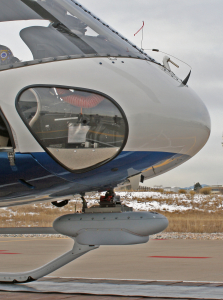Jun 5 2015
Logos Technologies announces its new compact, ultra-lightweight, wide-area motion imagery (WAMI) sensor system, Redkite. This represents a major advance for WAMI technology, say company officials.
 Redkite Pod on Helicopter
Redkite Pod on Helicopter
Most WAMI sensors are fairly heavy, but Redkite is housed in an aerodynamic pod that weighs less than 35 pounds--light enough to be mounted on helicopters, light planes and even tactical unmanned aircraft.
Yet despite its small size, Redkite can still image a 4-kilometer-wide area all at once and perform all of the image processing on board, within the pod.
“Redkite will be an invaluable tool for law enforcement, firefighters, search and rescue teams and other users,” says John Marion, president of Logos Technologies. “No longer will they have to depend solely on traditional narrow-field video cameras.”
The new WAMI sensor allows users to open and watch more than 10 video streaming windows at once within the monitored area. In addition, they can designate other areas as “watchboxes,” with the sensor providing an alert should it detect activity there.
Wide-area video imagery collected and geographically tagged in real time is also indexed thanks to Redkite’s sophisticated processing algorithms. Operators can later access this archive in order to trace related events over time.
For all its capabilities, Redkite requires less than 500 watts to operate, making it the smallest and most power-efficient WAMI sensor in the world. In addition, it is comparably priced to a traditional, high-resolution stabilized video camera.
Redkite was first flight tested on a Eurocopter AS350 helicopter in Denver, Colorado, in December 2014.